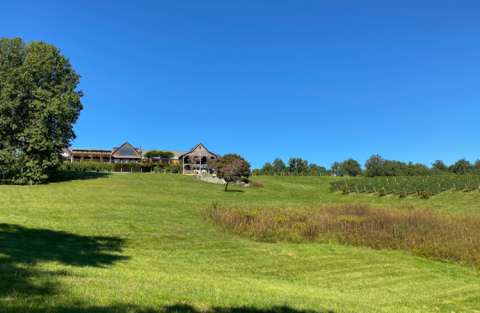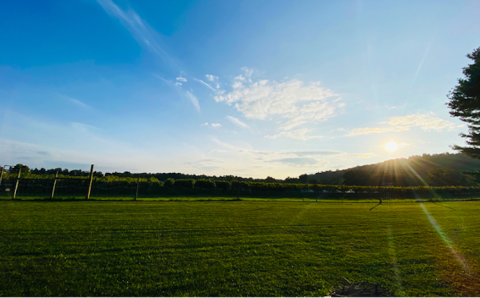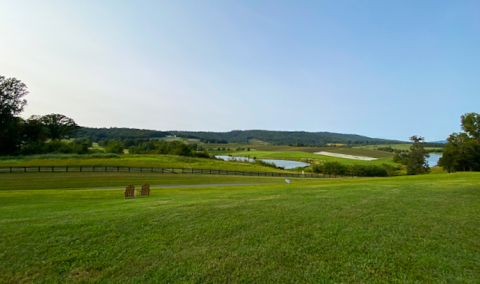3 November 2020 On American election day Sarah Phillips of Liv-ex introduces us to the current wine scene on Washington DC's doorstep and rates, inter alia, Trump Winery's output. Above: the view from Linden Vineyards' tasting room.
Government mandates were a bit more fun in 1619. That year, English colonists in Virginia ruled that every male settler should plant grapevines. It didn’t take off – thanks to American vines pests and diseases European varieties couldn’t survive – and the former president Thomas Jefferson’s efforts to plant a vineyard two centuries later weren’t successful either. If America’s most powerful wine lover couldn’t make it work, perhaps there was little hope for the state.
Wine drinkers today could be forgiven for believing that little has changed. Very few Virginia wines are sold outside the region, causing it to be something of a side note in wine education programmes. WSET Diploma texts briefly mention increased plantings of European varieties, and that Viognier is favoured. Before planning a trip to the state from my home in Miami in September, this was the extent of my knowledge. I had tasted exactly one Virginia wine.
Relatively speaking, Virginia’s wine production is still small. It has just over 3,000 acres (1,215 ha) planted (the UK has close to 9,000), but that total is growing steadily. Its 193 wineries ten years ago have increased to over 300 today. During my trip to the state, I attempted to understand the dynamics and signature styles of the better producers. It wasn’t straightforward
Searching for Virginia’s great white grape
The official state grape of Virginia is Viognier. Thanks to its loose bunches and thick skins, it manages to survive the humid summers while some other varieties struggle. Some examples, such as the Reserve 2015 from Barboursville, are excellent. Others are less exciting. When it lacks the acidity to counterbalance its weightiness, it can feel like hard work to drink.
This is why some feel that Viognier doesn’t quite deserve its crown. Among some producers, there’s a running joke that it was chosen only because of alliteration. ‘It has nothing to do with wine or winemaking, and everything to do with how it hits the ear’, according to Matthew Brown, wine director of King Family Vineyards. Virginia Viognier sells.
Jim Law, owner of Linden Vineyards in northern Virginia (and author of this Virginia vinegrower's diary), put it another way: ‘Personally, I don’t love Viognier’, he said, ‘but it does well in the vineyard. The challenge is to respect the variety and terroir, while producing a style that is also personally agreeable.’ Instead, he makes a range of steely Chardonnays, each expressive of his different vineyard sites at elevations of up to 1,400 ft (430 m).
Others tout Petit Manseng as Virginia’s next big (white) thing. Like Viognier, it has usefully thick skins and loose bunches. The best dry examples are refreshing and floral. Early Mountain, owned by Jean and Steve Case of AOL, has had particular success with the variety thanks to some careful vineyard management. Left to its own devices, Petit Manseng will accrue very high sugar levels before its acidity softens and its hallmark aromatics have fully developed. Early Mountain takes the unusual step of picking after rainfall to dilute the acids. They also blend batches picked at different times to achieve balance.
Others prefer to make it sweet – as the French do in Jurançon. Linden’s late-harvest Petit Manseng is a particular delight, bursting with mango-juice flavours. But, as everywhere else, sweet wines have fallen out of fashion. ‘It’s a brilliant wine that we struggle to sell’, Law tells me. This translates to good value: $28 for a 375-ml bottle of the six-year-old 2014.
Beyond these, there is a wide range of other white grape varieties. I tasted very good examples of Riesling (Linden), Albariño (Chrysalis), Sauvignon Blanc (Walsh Family) and – memorably – a spicy skin-contact Rkatsiteli from Stinson Vineyards. That one was not on my bingo card.
Reds: bordeaux blends and other stories
The red wine story is less complicated: Bordeaux varieties dominate. If you associate American Cabernets and Merlots with blockbuster fruit and structure, Virginia wine will cause you to revise your assumptions. The most charming examples combine Bordeaux elegance with American sweet fruit.
The best come from higher vineyards in the northern part of the state. This explains why RdV – Virginia’s most ambitious producer – chose sites at 650–850 ft (200–260 m) above sea level when planting in 2006. The results of this no-expense-spared operation are impressive: a muscular first wine (Lost Mountain, $175) and an elegant second (Rendezvous, $75). The word ‘classy’ features multiple times in my notes.
Nearby, Linden and Delaplane are also making very good bordeaux blends. So is newcomer Walsh Family Wines, whose red varieties are planted at up to 1,400 ft (430 m).
There are many exceptions to the Bordeaux rule, including Nebbiolo, Barbera and Pinotage, but the most distinctive is American variety Norton. Chrysalis Vineyards is home to world’s largest plantings of the grape. ‘I’d rather make the world’s best Norton than the world’s 400th Cabernet’, owner Jennifer McCloud told me.
When you meet McLoud, you get the impression that she does absolutely nothing in half measures. Besides owning the world’s largest plantings of Norton, her list of vinous achievements includes navigating government bureaucracy at the peak of the anthrax crisis to register Petit Manseng as an approved variety (via fax, in seven days), and being one of the early planters of Albariño, a grape she continues to champion in Virginia.
Norton is unusual – very acidic, lightly fruity and herbal. At Chrysalis, it’s made in a full range of styles: carbonic, off-dry, light, and full-bodied and age-worthy. But my favourite was the pet-nat. When I asked McCloud why she was such a strong advocate for the grape, she told me: ‘It has fruity, unusual character about it – it’s intriguing and interesting. I love that it’s out there.’ And then she added: ‘It’s the real American grape.’ [A Chrysalis Norton was a 2012 wine of the week – JR.]
Political Virginia
Speaking of patriotism, central Virginia is home to Monticello, Thomas Jefferson’s former home. Seven miles south of the plot where he attempted to establish a vineyard is Trump Winery and the adjoining Abermarle House. The property, which was once valued at $100 million, was acquired by Donald Trump in 2011 for $6.5 million after the previous owners fell into financial difficulties.
Trump’s low purchase price was part luck – it was peak financial crisis – and part manoeuvre. He gradually purchased land surrounding the house (including the driveway and the vineyard), which froze out other potential buyers and drove down the price. I know this story because I heard a gentleman at the next table recite it loudly to his friends. In response, a member of his party clapped her hands together, victorious: ‘Art of the deal, baby!’ I gulped down my Cabernet.
My assessment of the Trump wines was as follows: The sparkling wines were very good, the white and rosé were both good, and the reds were OK. Unlike many other guests, I left without purchasing a Trump Winery baseball cap.
Looking ahead
There is a sense of optimism about Virginia’s future. Its potential is being recognised, and this is attracting quality-focused winemakers and investors. Rick Tagg, winemaker at Delaplane Cellars, puts this down to the work of some stand-out producers: ‘RdV shows that it can be done; Linden shows it can be done for a long time and with consistency.’
But what will they plant? At the end of the trip, I made a list of my five favourite white wines. They came from four different varieties. Only Petit Manseng was represented twice – by one sweet and one dry wine. If I’d set out on a mission to find Virginia’s top white style, I’d failed.
Perhaps searching for one signature style misses the point. A tasting at Early Mountain illustrated what I’d come to enjoy about Virginia. We started with Petit Manseng and ended with some serious Bordeaux blends. In between, we tasted a pet-nat, a rosé, a Chardonnay and a surprisingly tasty Chambourcin. It takes a great deal of open-mindedness for a fine-wine producer to pour a selection like this.
So here’s my suggestion for some replacement alliteration: Virginia Variety. Viticulture here started with a mandate. Today it’s exciting because of its willingness to experiment and break away from convention.
Virginia variety
Not a top ten, but ten wines that offer a taste of the variety in the state.
Whites
Stinson Vineyards, Wildkat 2017
Skin-contact Rkatsiteli. Vibrant – zesty orange and sherbet. Full but refreshing. Grippy with bitter-orange and green-apple juice. Good fun.
Early Mountain, Quaker Run Chardonnay 2017
Weighty, with cantaloupe melons and peach. Refreshing. Started fermenting in autumn, stopped, and restarted in spring.
Barboursville, Reserve Viognier 2015
Lots going on – pear, sliced apple, quince, orange. Still very fresh, good weight on the palate.
King Family Vineyards, Small Batch Series Viognier 2017
A skin-contact wine that started as a two-barrel experiment. This year, 1,046 cases were made. Honeysuckle, apple and baking spices. Concentrated and grippy.
Walsh Family Wines, Estate Petit Manseng 2019
Delicate aromatics – honeysuckle, peach, orange peel. Quite concentrated on the palate. Bright and refreshing.
Linden Vineyards, Late Harvest Petit Manseng 2014
Luscious mango juice, peaches and a bite of acidity. Made from frozen grapes. Delicious.
Reds
Chrysalis Vineyards, Barrel Select Norton 2018
Very fruity and aromatic. Bright red cherries, blueberry muffin. Made with 100% carbonic maceration. Choose this ‘if you want to get Nortonised’, says Jennifer McCloud.
Early Mountain, Chambourcin 2019
Luminous purple in the glass – thanks in part to foot stomping of the grapes? Very fruity. Strawberry, cherry, Parma Violets. Drink lightly chilled.
Delaplane Cellars, Duet 2019
82% Merlot, 18% Petit Verdot. Perfumed, plummy nose with a splash of sweet red cherries. Elegant.
RdV, Rendezvous 2016
36% Merlot, 35% Cabernet Sauvignon, 29% Cabernet Franc. Bright and leafy on the nose – think sweet blackberry and dried leaves – and plush and silky on the palate. One for bordeaux lovers.



















